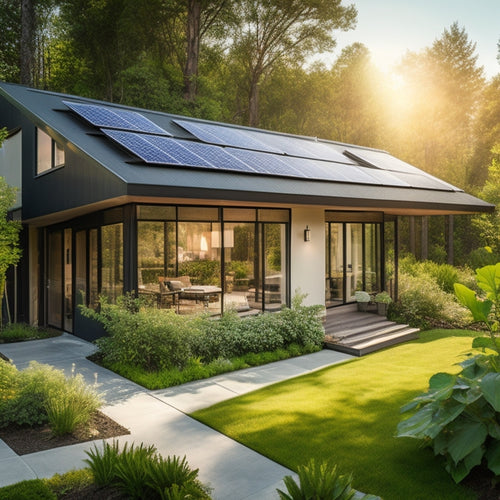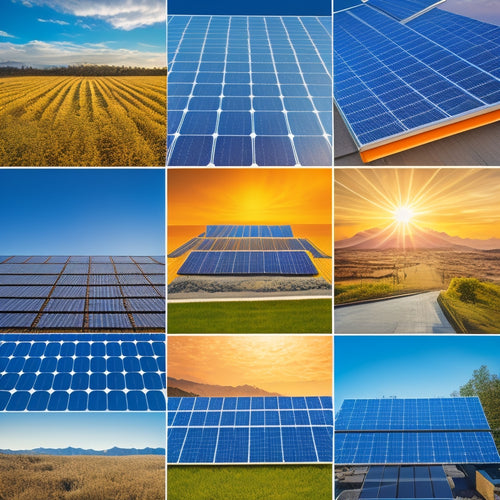
7 Affordable Solar Tips to Reduce Home Installation Costs
Share
You'll need to implement strategic cost-reducing measures to make solar energy a viable option for your home. Start by evaluating your energy consumption to determine the required size of your solar panel system. Maximize your roof's solar potential by reviewing its orientation, shading, and condition. Choose the right solar panels by considering their efficiency ratings, type, and temperature coefficient. Consider a grid-tied system to connect to the existing electrical grid and avoid expensive battery storage. Look for local incentives and rebates to offset the initial cost. You can also consider DIY installation and maintenance, and monitor your system's performance to guarantee peak energy production. By following these tips, you'll be well on your way to reducing your home installation costs and enjoying the benefits of solar energy - and that's just the beginning of your solar expedition.
Key Takeaways
- Analyze past utility bills to identify peak consumption and high-energy appliances, helping determine the required size of the solar panel system.
- Conduct a shading analysis to identify obstructions affecting sunlight exposure, ensuring optimal roof orientation for solar installation.
- Research and compare warranties, looking for long-term coverage of 25 years or more, to ensure reliable performance and minimize maintenance costs.
- Evaluate the feasibility of self-installation to reduce labor costs, but ensure compliance with local regulations and permits required for DIY installations.
- Investigate state tax credits and utility rebate programs to offset the initial cost of solar installation and maximize savings.
Assess Your Energy Consumption
Your home is a hub of energy consumption, with lights, appliances, and devices drawing power from the grid around the clock. To effectively shift to solar power, you need to understand your energy usage patterns.
Start by analyzing your past utility bills to identify peak consumption periods and energy-hungry appliances. Take note of the total kilowatt-hours (kWh) consumed each month and how it varies throughout the year.
You can also use smart plugs or energy monitors to track real-time energy usage and identify areas for improvement. This data will help you determine the size of the solar panel system you need to meet your energy demands.
Optimize Your Roof's Solar Potential
Optimize Your Roof's Solar Potential
Three key factors determine your roof's solar potential: its orientation, shading, and size. To maximize energy independence, you need to assess each factor carefully.
First, consider your roof's solar orientation, which affects the amount of sunlight it receives. South-facing roofs receive the most sunlight, while east- and west-facing roofs receive less. A shading analysis will help you identify areas where trees, buildings, or other obstructions cast shadows on your roof. This will enable you to position your solar panels for peak energy generation.
Next, evaluate your roof materials and condition. Verify your roof is in good condition and made of materials that can support the weight of solar panels.
The installation angle of your panels is also vital, as it affects energy production. A professional consultation can help you determine the ideal installation angle based on your roof's pitch and local weather conditions.
By optimizing your roof's solar potential, you'll enjoy long-term savings on energy bills and reduced maintenance costs, all while achieving energy independence.
Don't forget to check local regulations and weather conditions to confirm your solar installation meets specific requirements.
Choose the Right Solar Panels
When selecting solar panels, you'll want to evaluate two critical factors: panel efficiency and price.
A more efficient panel will generate more power per hour of sunlight, but it may come at a higher cost.
Panel Efficiency Matters
Efficient solar panels are the backbone of a cost-effective solar power system, and choosing the right ones can greatly impact your energy savings. When it comes to panel efficiency, you'll want to focus on the panel's performance and energy yield.
Look for panels with high efficiency ratings, typically above 20%. These panels can generate more power per hour of sunlight, resulting in higher energy yields and lower installation costs.
You'll also want to take into account the type of solar cells used in the panels. Monocrystalline silicon cells tend to be more efficient than polycrystalline cells, but they're often more expensive.
Thin-film solar cells are another option, offering a lower upfront cost but lower efficiency ratings.
When evaluating panel efficiency, be sure to take into account the temperature coefficient, which measures how well the panel performs in high temperatures. A lower temperature coefficient means the panel will maintain its performance even on hot days.
Compare Price and Quality
You've narrowed down your search to high-efficiency solar panels, but now it's time to contemplate the cost. Comparing prices and quality is vital to make certain you get the best value for your money.
When evaluating solar panels, consider the following key factors:
-
Brand reliability: Research the manufacturer's reputation, customer reviews, and ratings to make certain you're investing in a trustworthy brand.
-
Warranty comparison: Look for manufacturers that offer extensive warranties with long-term coverage, typically 25 years or more.
-
Efficiency and performance: Assess the panel's efficiency, temperature coefficient, and power output to guarantee peak energy production.
- Certifications and compliance: Verify that the panels meet industry standards, such as UL certification and compliance with local building codes.
Consider a Grid-Tied System
Most homeowners opt for a grid-tied system, which connects your solar panel array to the existing electrical grid. This configuration allows you to generate your own electricity and export any excess to the grid. You'll receive credit for the excess energy produced, which can offset your energy consumption during periods of low solar production.
The grid connection benefits are twofold. To begin with, it enables you to take advantage of net metering, where you only pay for the difference between the energy you consume and the energy you produce. This setup can lead to significant cost savings, especially during peak sun hours.
In addition, it eliminates the need for expensive battery storage systems, which can add thousands of dollars to your overall installation cost. By leveraging the grid as your virtual battery, you can enjoy the benefits of solar power without the added expense.
Look for Local Incentives and Rebates
You'll want to investigate local incentives and rebates that can greatly reduce the upfront cost of your solar installation.
State tax credits, for example, can provide a percentage of your total system cost back as a credit on your taxes.
Additionally, utility rebate programs may offer a one-time payment or ongoing bill credits for switching to solar energy.
State Tax Credits
One notable advantage of investing in solar energy is that many states offer tax credits to offset the initial cost of installation.
These credits can greatly reduce your upfront expenses, making solar energy more accessible and affordable.
To take advantage of state tax credits, you'll need to determine your state's eligibility and specific requirements.
Here's what you should consider:
-
Check your state's eligibility: Not all states offer tax credits for solar energy. Research your state's policies to see if you're eligible.
-
Understand the tax credit amount: The amount of the tax credit varies by state, so be sure to know how much you can claim.
-
Meet the installation requirements: Your solar panel system must meet specific installation requirements to qualify for the tax credit.
- Claim the credit on your tax filing: You'll need to claim the tax credit on your tax return, so be sure to keep accurate records and receipts.
Utility Rebate Programs
Beyond state tax credits, another way to reduce the cost of going solar is to investigate utility rebate programs. These programs offer incentives to homeowners who install solar panels, typically in the form of a rebate or credit on your utility bill.
To take advantage of these programs, you'll need to determine rebate eligibility, which often depends on factors like your location, system size, and installation date.
Once you've confirmed your eligibility, you'll need to submit a program application, usually through your utility company's website or by mail. Be prepared to provide documentation, such as your system's installation certificate and a copy of your utility bill.
The application process typically takes several weeks to a few months, so plan accordingly. Some utility companies offer rebates on a first-come, first-served basis, so it's crucial to act quickly to secure your spot.
Additionally, rebate amounts can vary greatly between programs, so research and compare offers to maximize your savings. By taking advantage of utility rebate programs, you can considerably reduce the upfront cost of going solar and start generating clean energy sooner.
DIY Solar Installation and Maintenance
Most solar panel systems require minimal maintenance, but performing routine checks and repairs can greatly extend their lifespan.
As a homeowner, you can take matters into your own hands and perform DIY solar installation and maintenance tasks to reduce costs. This involves selecting the right solar panel types and installation tools for your specific needs.
Here are some DIY tasks you can perform:
-
Inspect and clean solar panels: Regularly inspect your solar panels for dirt, debris, and signs of wear. Clean them gently with a soft brush and mild soap to guarantee peak energy production.
-
Check electrical connections: Verify that all electrical connections are secure and not loose. Tighten any loose connections to prevent energy losses.
-
Monitor for signs of wear: Keep an eye out for signs of wear on your solar panels, such as cracks, broken glass, or loose frames. Address these issues promptly to prevent further damage.
- Perform routine software updates: Update your solar panel system's software regularly to confirm it's running efficiently and effectively.
Monitor and Adjust Your System
By taking charge of your solar panel system's maintenance, you've guaranteed it's running smoothly and efficiently. Now, it's important to monitor and adjust your system to optimize its performance. Energy monitoring is vital to confirm your system is generating the expected amount of power.
| Parameter | Optimal Range | Adjustment Needed |
|---|---|---|
| Voltage | 300-600 V | Check for loose connections or faulty inverters |
| Current | 5-10 A | Inspect for shading or debris on panels |
| Temperature | 25-40°C | Verify proper ventilation and cooling |
| Energy Output | 80-100% of capacity | Check for inverter efficiency and panel cleanliness |
| Inverter Efficiency | 95-98% | Update firmware or replace outdated inverters |
Frequently Asked Questions
Can I Install Solar Panels on a Metal or Tile Roof?
You can install solar panels on a metal or tile roof, but you'll need specialized mounting systems for metal roof installation and extra tile roof considerations, such as ensuring waterproofing and structural integrity.
Will Solar Panels Increase My Home's Insurance Costs?
You won't break the bank, but yes, installing solar panels will likely increase your home's insurance costs - by a whopping 1-5%! This minor hike in insurance premiums is due to the added value of your system, which your policy coverage will now need to protect.
How Long Does It Take to Install a Solar Panel System?
You'll typically spend 1-3 days overseeing the installation process, but the entire installation timeline can take 2-6 months from permitting to final inspection, depending on local regulations and the complexity of your system's design.
Are Solar Panels Resistant to Hail and Extreme Weather?
You'll be relieved to know that solar panels are designed to withstand harsh weather conditions, including hail damage; in fact, most panels are tested to resist impacts from hailstones up to 1 inch in diameter, ensuring ideal weather durability.
Can I Sell Excess Energy Back to the Grid?
You can sell excess energy back to the grid through net metering, earning energy credits that offset your utility bills; exploring net metering benefits and energy credit options will help you maximize your solar investment's financial returns.
Conclusion
You've made it to the finish line! By following these 7 affordable solar tips, you've considerably reduced your home installation costs. Now, you're utilizing the power of the sun to fuel your daily life. As you bask in the glow of your newfound energy independence, ask yourself: what will you do with the money you're saving on your electricity bill?
Related Posts
-

Integrating Solar Panels Into Home Design
Integrating solar panels into your home design greatly enhances energy efficiency and lowers utility bills while addi...
-

Solar Power Backup Solutions During Outages
Solar power backup solutions guarantee you have reliable energy during outages, providing essential power when the gr...
-

Comparative Analysis of Top Solar Brands
To conduct a comparative analysis of top solar brands, focus on key metrics like durability, energy efficiency, and s...


